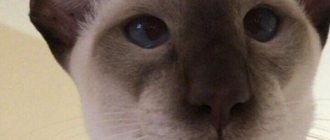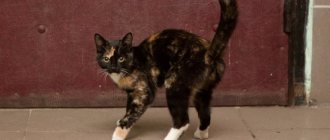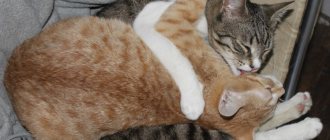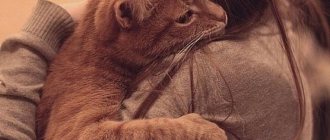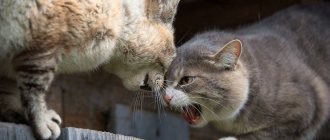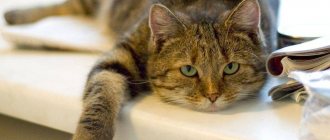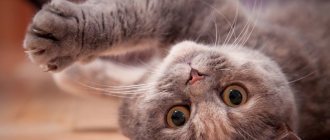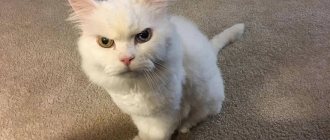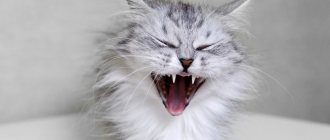What documents for a kitten must be given when purchasing it?
A purebred kitten must have documents confirming that it has the declared breed and the declared level of health. It is advisable that upon purchase you are given a veterinary passport, one copy of the contract and a metric/pedigree or their equivalent (for American systems). If they give you a metric, then you don’t need to ask for a pedigree, and, therefore, vice versa: the pedigree is given without a metric. Ideally, the breeder should give you one of these two documents, regardless of whether you are taking a kitten for castration or breeding.
ATTENTION!!!
Conscientious breeders do not sell kittens with documents for one amount, and without documents for another (cheaper). In any system, the litter is registered as a whole, and documents are issued for all kittens at the same time; a conscientious breeder cannot have kittens without documents in principle!
The preparation of documents for a litter in the club/system itself is quite inexpensive, but to obtain them you must strictly follow the rules of the system. Pedigree kittens with documents are expensive not because they have documents (papers), but because these “pieces of paper” guarantee the breed of the animal and its physical and mental health (to a certain extent). The documents also allow you to find a breeder, get advice, help, and even return the kitten and the money for it if problems arise.
Kitten veterinary passport
The veterinary passport indicates the name, gender, breed of the cat, its date of birth, the name of the owner and/or breeder. But the most important thing is that the passport must contain vaccination records with a special sticker, a veterinary clinic stamp and a doctor’s signature.
Veterinary passports come in different designs. The standard passport is blue with blue security inscriptions “pet”, but if they give you a passport of a different type, it’s okay. Different regions have different requirements, if anything happens, your veterinarian will make you a new correct passport and offer to keep the old one, just in case.
It is important to understand that every purebred kitten must have a veterinary passport, but it does not in any way confirm its breed, since it is filled out by a veterinarian or breeder, and clubs and exhibition systems are authorized to guarantee the breed.
What is the difference between a purebred Maine Coon and a purebred one? Availability of documents?
As a rule, a purebred animal is understood as an animal with documents, a representative of the breed, not a mestizo. A purebred Maine Coon is a worthy representative of the breed, meeting the Maine Coon standard, a high-quality Maine Coon, suitable for breeding and exhibitions and receiving high marks from experts.
Even excellent producers have unsuccessful kittens, purebred and healthy, but not purebred. As a rule, such kittens become pets (pets), although it is not always possible to recognize this at an early age. It happens that a nondescript kitten grows into a purebred animal, and sometimes vice versa. Buying animals for breeding is always a certain risk. About the breed Choosing a kitten Documents Property Nutrition Health Contents Education Care Neutered Cattery Breeding Exhibitions
Metrica\kitten slip (“kitty”)
This is the kitten’s birth certificate, which is issued upon its activation in the club/system. The metric indicates the kitten's name, its breed, gender, color, date of birth; names and colors of the kitten's parents; name of the breeder, etc. The document must have the emblem of the system to which the kitten belongs.
Also, the metric of the European system must bear the seal of the club that issued it, and the signature of the responsible club functionary who activated the kittens, so that in the future it can be exchanged for a pedigree.
In American systems, based on the metric (slip), a kitten is registered and a pedigree is ordered at the central office.
A European breeder may refuse to give kittens for castration, but he is obliged to at least show it to you. And it’s better to ask her to give her back, the club still knows that the kitten is for castration and will not give you the pedigree just like that.
In American systems, such problems do not arise, since all breeding restrictions are indicated when registering a litter.
Agreement
An agreement between the breeder and the owner is concluded when selling or purchasing a purebred kitten, to clarify some agreements between them. For free.
The main cost of a purebred kitten sold depends on the quality, uniqueness of the breed and origin. Each breeder sets the cost of a kitten (the fruit of his breeding work), but the average price in quality nurseries starts from about 5-10-25 thousand rubles. (castrato) and 40-50-100 thousand rubles. (show kitten for breeding work and exhibitions). In principle, a thoroughbred and high-quality producer cannot be cheap!
Before you buy an animal on the market or through dubious advertisements, count the amount you will pay for the treatment of a sick kitten bought from someone unknown, and if it dies in the first weeks, also count your nerves and the tears shed by your family. Is it worth it? Believe me, not all kittens in nurseries are used for breeding, and therefore for a small amount you can find a good purebred kitten from a good breeder, of which there are plenty throughout Russia and beyond, you just need to be more attentive and thorough in preparing for the purchase of your kitten and slowly search.
Rate and share!
Pedigree (“roduha”) of the kitten
The pedigree indicates several generations (3-5) of your kitten’s ancestors (their nicknames, colors and pedigree numbers). The pedigree must contain the emblem of the association (system), the name of the club, nursery, the name of the breeder and the name of the owner of the kitten, information about the kitten itself.
Be careful: in the pedigree, in the “owner” column, your name must be indicated, not the name of the breeder! To do this, you need to either obtain a pedigree yourself, or agree in advance with the breeder on its registration.
In the European system, the pedigree must have a number, the seal of the club and the signature of its leader. In American ones, only the number is indicated, since the pedigree is issued by the system.
If the kitten is to be castrated, then in the European system they may give you a pedigree without a number or with a “pet” stamp, or not issue it at all, but again it would be better to negotiate so that they give it.
If you yourself draw up a pedigree based on metrics in a club specified by the breeder, then you must request it before the kitten turns one year old. This applies only to European systems; in American systems, the owner can request a pedigree based on the breeder slip at any time if the cat has been registered in the system. In American systems, pedigrees are informational in nature, and the pedigree of a cat is confirmed by registering the litter and the cat itself in the system in accordance with its rules.
However, you will not need a pedigree if you do not engage in breeding.
Is it possible to buy a pedigree for a cat?
Many owners believe that breed clubs sell documents. A pedigree can be purchased by anyone who wants their pet to have documentary evidence of its thoroughbred. This is wrong. It is usually impossible to buy a pedigree without a meter or examination and conclusion of an expert commission. However, unscrupulous clubs sometimes neglect this rule. Fortunately, this does not occur often and is suppressed in every possible way in felinological systems. Future owners of a purebred kitten should think in advance about the need for a pedigree. Saving when buying a pet can lead to the fact that it is simply impossible to legally obtain a pedigree for a cat without documents. Don't try to buy paper. Just as you should not abuse obtaining “certificates of conformity” - a cat with an unconfirmed line of genetics is unpredictable in breeding. In addition, the offspring of such an animal may be seriously ill.
Certificate of registration of the cat in the system
In American exhibition systems, the main document of a cat is a registration form, which indicates the registration number of the animal. This document certifies the cat’s membership in the relevant system, and, consequently, the right to receive titles and pedigrees for it at the central office of the organization, and to register the litters received from it.
In addition to the number, the form indicates the name of the cat, its breed, color, its parents, date of birth, name of the owner and breeder of the animal; the logo of the system and the signature of its secretary (facsimile).
In fact, the registration certificate is also the system's legal proof of cat ownership. Therefore, usually, such a certificate is issued to the new owners of the cat, after purchasing it from the breeder, based on the received metrics. If the breeder registered the cat before the sale, then he is required to issue another document - a transfer.
The metric is the initial document about the origin of the animal, drawn up and issued at the time of registration of the litter (inspection of animals by a felinologist in the organization).
An official organization registered with government agencies has the right to issue metrics. If an organization does not have a current status or does not have a type of activity (see the Unified State Register of Legal Entities extract), then such an organization does not have the right to draw up documents on the origin of animals. No other types of activities of the organization can replace the OKVED code 01.49.5 - breeding of domestic animals.
When activating a litter, the breeder assigns a nickname to the kitten, indicating the name of his cattery. A felinologist, the curator of the breed, examines the kitten for the absence of defects and significant deficiencies, then registers this animal in the breeding registries (breeding books of cats) under an individual registration number. The kitten's metric includes the registration number (according to the cat breeding book), the animal's name, date of birth, breed, color, breed and color index, parents. Metrics are prepared on the organization's letterhead and certified by the seals or stamps of the organization and the signature of the organization's employee (authorized person).
In fact, public cat clubs often issue certificates for kittens without animal names. The question arises - where and how was this animal examined and registered, without a nickname?! Perhaps no one in the organization has ever seen such animals. New owners of kittens are told when selling – call it what you want! Think about the purebred nature of such animals and the quality of control over paperwork in such an organization.
Sometimes the metric forms do not contain the names of the parents, which means that there is no registration of mating of breeding animals. In this case, when registering a pedigree, any animal can be entered, which raises doubts about the origin of the kitten itself.
The documents on the origin of some public organizations indicate that the breeder is responsible for the accuracy of the data in the pedigree! However, the breeder is not the founder of the organization or its employee. The breeder is just a member of the organization who, according to current legislation, cannot be held responsible for the affairs of the organization. Codes of economic activity for breeding domestic animals are held by the organization, not by the breeder. Therefore, responsibility for the accuracy of information that is published in metrics or pedigree on the organization’s letterhead and certified by the seal or stamp of the organization can only be borne by the organization itself, whose details are indicated in the document. The breeder can only be responsible for the health of his movable property - the kitten.
Often, the metrics of public organizations of members of WCF, CFA, FIFE, TICA use the trademark of foreign organizations that do not have accreditation, branches or representative offices in the Russian Federation. Such cat clubs are registered abroad in Germany, the USA, and Sweden; in those territories, breeders are provided with cat breeding services, but not in Russia. Therefore, the status of the activities of WCF, CFA, FIFE, TICA breeders on the territory of the Russian Federation is illegal and, as a rule, without registration with the Tax Authority of the Russian Federation. The use of someone else's trademark in documents made in Russia (in member clubs of WCF, CFA, FIFE, TICA) without written agreements certified by Rospatent of the Russian Federation is prohibited. By purchasing an animal with such documents, you can fall under Article 180 of the Criminal Code of the Russian Federation, which provides for a real sentence for the distribution and storage of counterfeit products - metrics, pedigrees, exhibition documents, etc.
The buyer of a kitten must receive a birth certificate and a veterinary passport from the breeder. In accordance with the Federal Law “On the Protection of Consumer Rights,” the buyer has the right to receive details of the manufacturer and producer of the product (kitten), that is, to receive the TIN or OGRN of the organization (cat club). If the cat club is not registered with government agencies of the Russian Federation or does not have OKVED codes for breeding domestic animals, then the TIN must be provided by the breeder himself, who is engaged in economic activities of breeding purebred cats. If you refuse to provide the kitten buyer with registration information, you should know that this is an illegal breeder, with all the ensuing consequences.
Therefore, use the opportunity to start your search for breeding animals from official professional organizations, where breeders always have reasonable prices for kittens and where the organization guarantees in writing the standard of the animals.
Transfer to own a cat
A transfer is a document confirming the transfer of a cat from one owner to another. It is not required if, when purchasing a kitten, a pedigree was not made or registration in the system was completed, and also if, when registering one of these documents, the name of the new owner was already known and entered in the appropriate columns.
A de jure transfer for owning a cat exists in all exhibition systems, but in practice in European systems they prefer to issue kitten buyers with birth certificates so that they independently draw up pedigrees for themselves, and there are no official transfer forms. In these systems, transfers are issued by clubs only in cases of urgent need or if the new owner (not mentioned in the pedigree) wishes to register the cat in American associations. In the latter, transfers are more popular, although breeders also try to do without them.
In addition, in some American systems it is possible to rent a cat for a certain period. That is, the cat becomes yours and in the documents for the rental period you are indicated everywhere as its owner and are fully responsible for it.
What is metric and pedigree?
The above document is a compilation of data describing the origin of the animal. Pedigree is necessary for further breeding of cats. Without it, it is impossible for the “mustachioed” to participate in breeding programs. The presence of an official document confirming the breed pleases the pride of the pet owner.
Using the pedigree, you can track whether the selected partners have closely related connections. The document is also necessary if it is possible to obtain a rare color based on the color of the ancestors’ coat.
By metric we mean a document confirming the breed of an animal.
Veterinary certificate form No. 1
If a kitten comes to you from another region, it must have veterinary form (certificate) No. 1 (transportation permit). It indicates the name, gender and age of the kitten, its breed; Breeder's name; There is also a doctor’s signature and a clinic stamp. If there is no such certificate or it was not given to you, then it’s okay, but if there is one, it means that the breeder did everything correctly and according to the law.
ATTENTION! If a kitten does not have documents, then it is not considered a purebred! Participation in breeding without a pedigree is impossible!
0
Why do they issue documents for animals?
Having documents for a cat is a prerequisite for participation in exhibition events. If a pet is bought for the soul and does not plan to receive honorary titles, then this is not a reason to refuse official registration. A basic set of documentation is necessary not only for exhibitions, but also for:
- Border crossing
. Moving to another country or another city within the country will be impossible without providing the required papers for a pet.
- Solutions to controversial issues
that arise when a pet is kidnapped or lost. Trying to prove ownership in court with words alone is a lost cause.
- Proof of breeding value
. The desire to breed a breed can come spontaneously. If everything is prepared in advance, you won’t have to look for where to buy documents for a cat. You will also have to deal with mandatory paperwork after the birth of kittens.
Before purchasing, familiarize yourself with what all the necessary papers look like. This will eliminate the subsequent search for information on how to prepare documents for a kitten yourself.
International veterinary passport
A veterinary passport is issued, as a rule, at a veterinary clinic when the first vaccination is given (in large nurseries this is done at home by a permanent veterinarian who provides medical care for all animals in a given nursery). In the veterinary passport, in addition to basic data about the kitten (name, breed, gender, date of birth, color), there must be notes on all vaccinations given to this animal (date of vaccination, vaccine), in addition, it contains data on deworming (deworming ). Having a veterinary passport is required if you plan to attend exhibitions or travel somewhere with your pet. EXAMPLE OF PASSPORT.
Purchasing a passport
After the first vaccination of the kitten, a veterinary passport is issued. The doctor fills out the document in a few minutes, and the form itself costs 100 rubles. In nurseries, the breeder issues a passport for the animal.
To obtain a veterinary passport for an adult cat, you should contact a medical institution, where a doctor will fill out the necessary fields.
The owner can independently buy a blank form and make entries (gender, breed, age, name of the animal, information about the owner).

